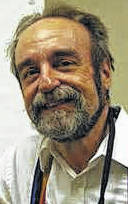
There are times, I must confess, when the trials — the crowds and the clouds — of public work at Perkins Observatory sap my strength and leave me wanting.
But the job has its compensations, and the moon is one of them.
The adult in me wants to think of the moon as a 2,000-mile wide, cold, heartless hunk of rock, the only natural satellite of planet Earth. He knows the moon’s average distance — about a quarter of a million mile — as it orbits once a “moonth” around our planet.
The adult in me thrills to the view through binoculars or a small telescope. He notes with interest the craters, which were formed billions of years ago as gigantic pieces of space debris crashed into the moon’s still-soft surface as the moon and Earth, both still in the process of formation, continued to accrete new material.
He observes the dark areas, the lunar maria, or “seas,” the results of even more enormous impacts. He knows that the impacts led to gigantic craters, basins that filled with liquid rock from the moon’s still molten interior. He envisions the giant lakes of lava slowly cooling and leaving those enormous flat plains we call lunar “seas.”
The adult in me sees those craters and plains as signs that our planet Earth formed from incredible violence as little rocks slammed together to form a larger and larger ball of liquid rock we call home.
The adult in me imagines a time 4.25 billion years ago when an enormous asteroid the size of Mars slammed into the still-molten Earth. He knows that out of that collision splattered forth the material that would eventually coalesce to form the moon.
The adult in me forgets that for millennia the moon has illuminated many a joyful liaison between lovers.
He forgets that long before the invention of the telescope, humans saw the moon as a beautiful goddess and that the light from her face was to them the force of life on Earth. Her radiant glow shone down upon plants, animals, and humans alike and, we imagined, kept us alive every moment of our lives.
The best compensation of my job at Perkins is that I am occasionally reminded with great force of those simple and wondrous things.
How old were you? Ten? Twelve? I’m sorry. I forgot to ask. I was distracted and tired from one too many stargazing sessions for people like you.
What was the moon to you? Not rock, not satellite, but an emblem of purest love, a reminder of a grandmother departed from this Earth these past few years.
The entryway at Perkins was filled with the din of thirty voices like your own, and I barely heard your story. You told me of your grandmother, who loved the stars and who chose, three months before her death, to go to a “place like this” to see the glories of the heavens close up before she died.
You told me how, after her passing, you had lain awake in bed, and how you heard like a gentle breeze the pet name that only she had called you. “Mitzy,” the voice called, and it drew you to the window, where a radiant full moon illuminated the earth below.
You told me that as you looked, the moon burst into a million scintillas of light. And you told me how the brilliant fragments formed shimmering words against the velvet background of night.
They were words your grandmother had spoken to you only once in the all-too-brief time that you had known her. They were simple words, full of power: “I love you.”
“Did you dream it?” the adult, the damned skeptic, in me asked.
“No,” you whispered, and the 12-year-old inside me believed you.
I thank you, child, and I’m sorry. With our cities and our streetlights, the adult in us has ripped the stars from you, but we will never take the moon.
I thank you for reminding me that the moon is more than a hunk of senseless rock floating in an endless void.
She graced our skies for four billion years before we ever walked the Earth, and she will abide endure as an endless source of beauty long after humans have passed into oblivion.
She is power. She is beauty. She is a secret, unforgettable tryst in the night. But most of all, to the 12-year-old inside us all, she is that love spoken only once in a lifetime filled with endless yearning.


